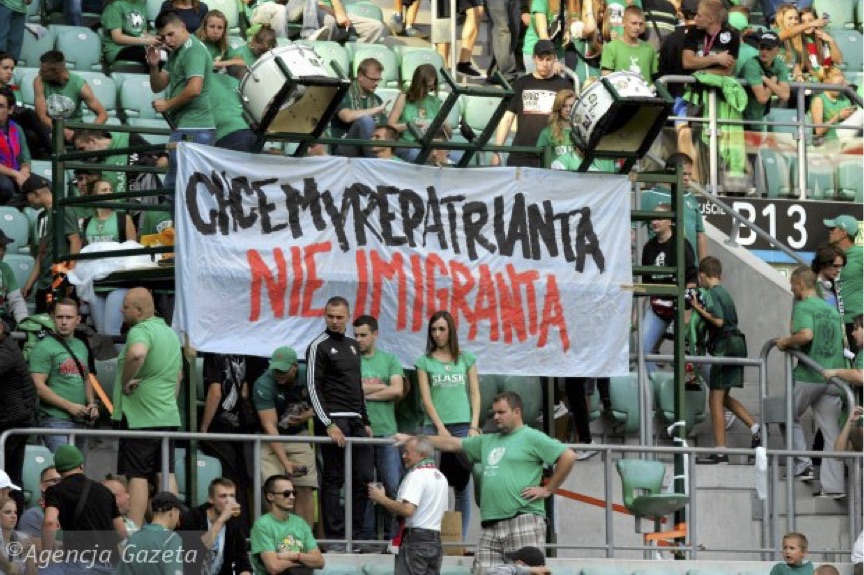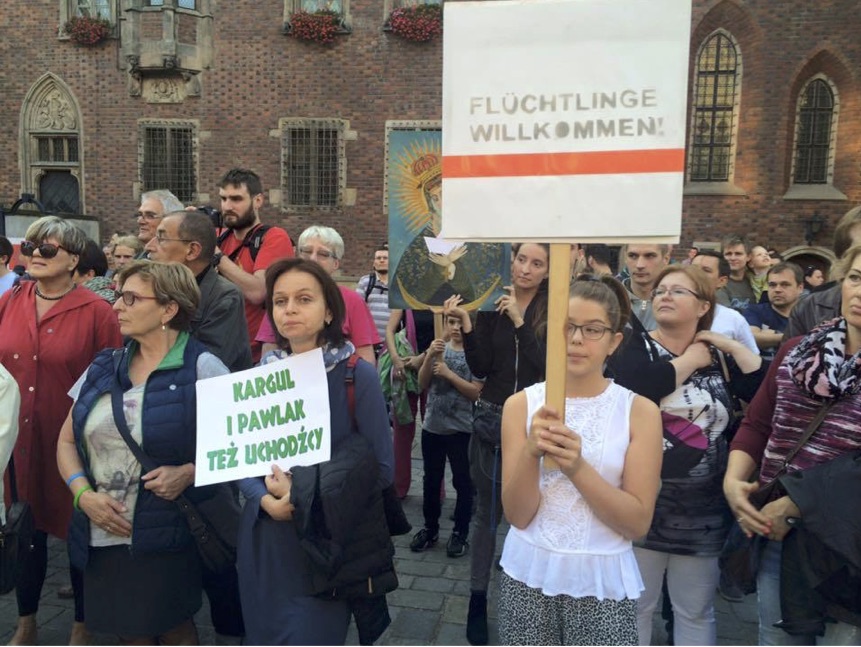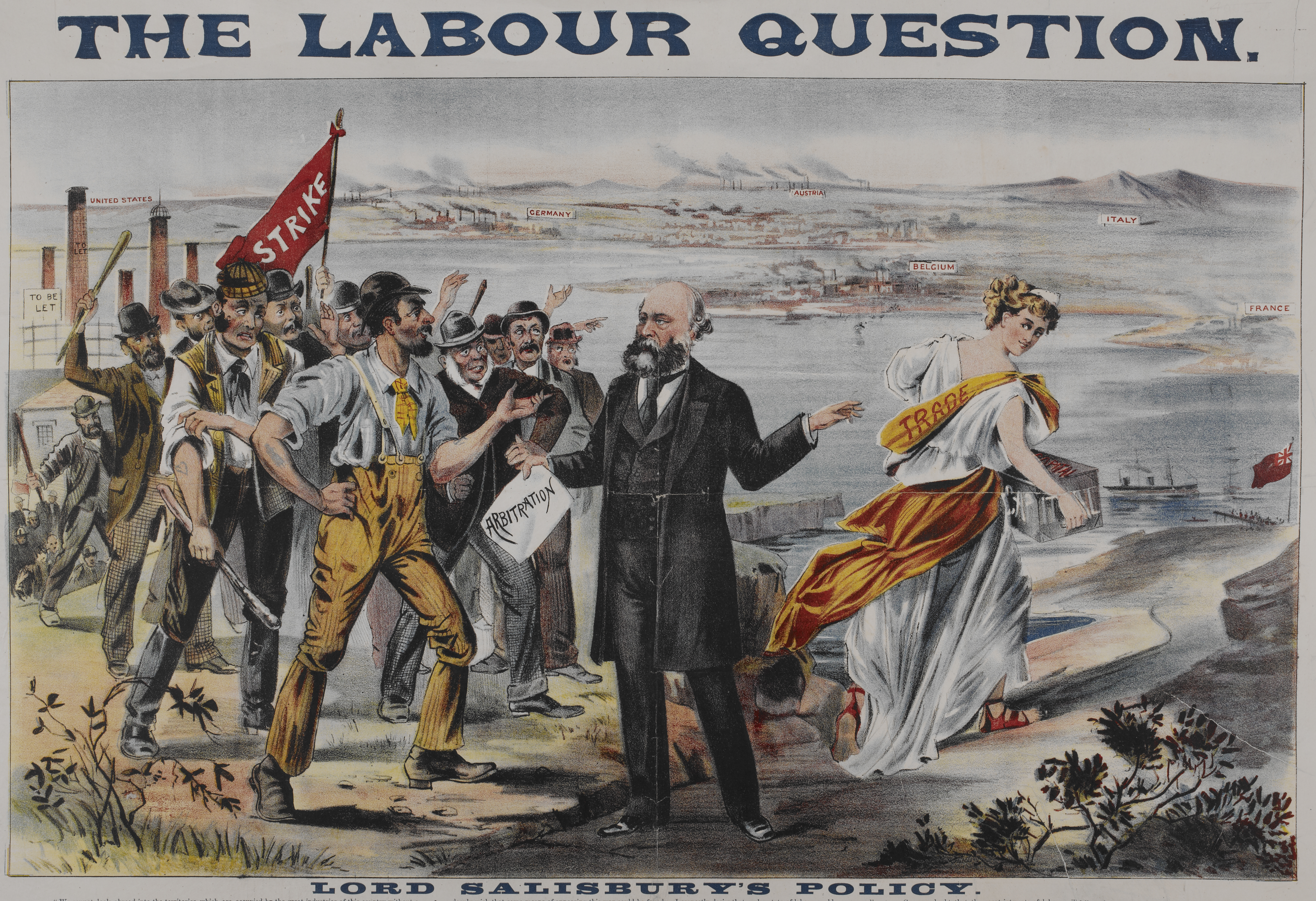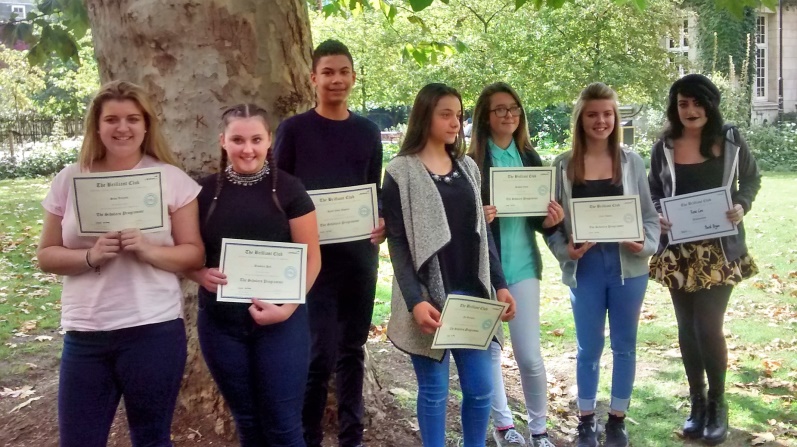In this essay, Jim Bjork looks at Poland’s recent history of assimilating culturally distinctive newcomers.
****
On 12 September 2015, people in the Polish city of Wrocław engaged on each side of the debate over policy toward the growing number of refugees coming to Europe from the Middle East, Africa and Asia. The issue was, by then, a familiar and thoroughly pan-European one. But the language deployed at these demonstrations reflected some distinctively Polish points of reference. At a football match, supporters of the local team unfurled a banner declaring ‘We want the repatriate, not the immigrant.’ Popularized by right-wing groups such as the Pan-Polish Youth, the slogan combined a rhetorical welcome to so-called ‘repatriates’—residents of current-day Ukraine or Central Asian republics who could claim Polish descent—with rejection of ‘immigrants’, ostensibly unassimilable foreigners, who had been primarily characterized as ‘African’ in earlier demonstrations but who now figured as agents of ‘Islamization’.

The use of the word ‘repatriates’ was an especially evocative rhetorical move in western Poland. This not only referred to the potential immigration of a relatively small number of ethnic Poles currently living outside of Poland’s borders. It also touched on the life stories and family histories of hundreds of thousands of current residents of Wrocław and the surrounding region of Lower Silesia. ‘Repatriate’ was the term applied to roughly 1.5 million people who were compelled to leave territory that had constituted the eastern half of Poland before the Second World War but that became a part of the USSR after the war and that now make up the western portions of Belarus and Ukraine and parts of Lithuania. The thrust of the Polish Right’s symbolic embrace of this group was clear enough: both the post-war repatriates and current/future migrants using the same term had to be understood as automatic insiders within the Polish community, and their proprietary claim to the rights and benefits offered by the Polish state (and by extension the European Union) needed to be asserted against ‘real’ foreigners (‘immigrants’). Although the specific demonstrations cited here were spearheaded by a relatively marginal far-right group, this view of migration was broadly shared by much of the Polish electorate, as shown by the triumph of the Law and Justice Party and strong performance of other right-wing parties in the most recent parliamentary elections.
On the same day, in the market square in the centre of Wrocław, a very different demonstration was invoking the history or post-war ‘repatriation’ in a very different way. A number of placards at this rally explicitly rejected the ostensible contrast between ‘repatriates’ and ‘migrants’, redefining both as ‘refugees’. Some signs noted that ‘Wrocław was rebuilt by refugees’, a reference to the city’s wholesale re-population and partial reconstruction after the Second World War, as almost all of its previous German inhabitants fled or were expelled, and hundreds of thousands of in-migrants—many from the former Polish East, though also many form central Poland—took their place. Describing as ‘refugees’ people who had been forced to leave their homes and move to an area most had never seen before, let alone inhabited, seemed a much more honest use of language than the euphemistic ‘repatriates’, which suggested the soothing fiction that they had all simply ‘come home’. Other demonstrators held up signs saying that ‘Kargul and Pawlak [were] also refugees’. As almost all Poles (but few non-Poles) would know, this referred to the popular film Sami Swoi (1967), a title that can be translated as ‘just folks’ but that conjures a stronger sense of in-group intimacy, along the lines of ‘just among ourselves’. Kargul and Pawlak were the film’s main characters, members of families that had been feuding neighbours in the old homes in rural eastern Poland before both ended up in Lower Silesia after the war. Jan Pawlak moves to the United States for a time, but when he returns he discovers that the two families had now reconciled and, indeed, intermarried in their new common homeland.

Demonstration in support of refugees in the Market Square in Wrocław on 12 September: Sign on the left reads ‘Kargul I Pawlak [were] also refugees’; sign on the right reads (in German) ‘Refugees welcome’. An image of the Black Madonna of Czestochowa, Poland’s most famous icon, can be partially seen in the centre.
These duelling deployments of Poland’s post-war migration history show that recent debates about refugees from outside Europe are not only about Poles’ or Europeans’ understandings of those migrants. They are also about Poles’ view of Poles and Europeans’ views of Europeans. These debates are, in other words, about an ostensible contrast between mass movement that is deemed normal and unremarkable, the circulation of like among like, and mass movement that is deemed pathological (sometimes quite literally). This contrast was, for example, central to Viktor Orban’s notorious remarks portraying the recent influx of refugees as a threat to ‘European identity’ while simultaneously celebrating migration within the EU as the ‘experience [of] freedom itself’. It is unsurprising, then, that advocates of a more welcoming stance toward current refugees have critiqued this contrast from both sides: not only making the strange familiar (humanizing current refugees) but also making the familiar strange (revealing the extent of cultural difference within putative ‘homogeneous’ communities).
The placards just discussed, especially the reference to Kargul and Pawlak, might seem to be playful gestures, gently tweaking pop cultural memories. But they were also, for those thinking them through carefully, genuinely provocative, tugging at strings connected to some of the most painful and divisive events in modern European history. They invited observers to recall the suffering not only of hundreds of thousands of Polish refugees from the East, but also of millions of German refugees who fled from the territories that the descendants of ‘repatriates’ now called home. Perhaps even more provocatively—and so beyond what Sami Swoi was willing to engage, even in the context of comedy—the invocation of post-war migration could trigger reflection on relations between, on the one hand, the hundreds of thousands of natives of Poland’s western territories who were deemed Polish and so remained in the region (so-called ‘autochtones’) and, on the other, the hundreds of thousands of newcomers to the region, both ‘repatriates’ from the lost eastern territories and ‘newcomers’ from central Poland. The nationalist view, shared by leaders in both Eastern and Western Europe at the time, that this kind of post-war migration had involved an un-mixing of people, resulting in cosily homogeneous local communities, failed to correspond to realities on the ground. Many ‘autochtones’ viewed in-migrants as foreigners–indeed, often as ‘Ukrainians’ rather than genuine Poles—bringing an ‘Asiatic’ civilization into their ‘European’ communities. Many ‘repatriates’ and ‘newcomers’ returned the favour, characterizing the local population as ‘Germans’ posing as ‘Poles’ and accusing them of hiding Nazi pasts and sympathies. Even the clergy of the Roman Catholic church, the one important cultural institution shared by the vast majority of both indigenous and in-migrant residents, readily characterized their parishes as ‘mosaics’, made up of distinct communities with different geographic origins and different cultures who largely kept to themselves and only very gradually began socializing and eventually inter-marrying across what were essentially ‘ethnic’ lines.
In her introductory post to this blog, Jessica Reinisch rightly strikes a note of caution about the uses of history and the invocation of historical ‘lessons’. No historical example is exactly like any contemporary phenomenon, just as no historical example is exactly any other historical example. Perhaps more important, even if we accept that an episode from the past is strikingly similar to a current development, we are still left to unpack the meaning and implications of the past episode. Poland’s migration history after the Second World War is no exception. To begin with, should we look back at this history as a success story or as a cautionary tale? If our criteria are the achievement of geopolitical stability, the avoidance of violence, and the long-term integration of newly resettled populations, then the post-war era featured some impressive elements of success. Even if people thrown together by the demographic upheaval of the 1940s did not originally see themselves as part of a shared national community, most seemed to develop such an identification over time. But there are caveats to such a verdict. Already in the first several years after the war, many Jewish Holocaust survivors who had initially resettled in Poland’s new western territories now emigrated from Poland altogether. Antisemitic sentiment, sometimes escalating into physical violence, often played a decisive role in this additional round of uprooting. Over subsequent decades, hundreds of thousands of people who initially had been deemed ‘ethnic Poles’ after 1945 have decided that they had been miscategorised and have migrated west as ‘ethnic Germans’. Again, non-Catholics, including Protestant Slavic-speaking residents of Masuria, were especially likely to feel that their initial welcome into the Polish national community was ineffective and unconvincing. Even many of those who have remained in Poland up until today have recently re-identified as ‘German’ and/or as members of newly recognized ‘Kashubian’ or ‘Silesian’ nationalities.
If we view post-war integration of intra-European migrants as a qualified success, the natural follow-up question is: which policies worked, and which did not? Proponents of a ‘strong’ integration model (French republicanism is the most familiar example, though structurally similar models can have different ideological content) could plausibly point to the integrative power of Poland’s normative national mythology (a literary canon; sense of historical mission; pantheon of heroes). People now defined categorically as ‘ethnic Poles’ may have had little in the way of genealogical connection to this narrative, but they nonetheless came to embrace it as ‘theirs’. As just noted, however, for large numbers of ‘Poles’, this embrace turned out to be temporary acquiescence; they eventually came to conclude, in varying ways and for various reasons, that Poland’s hegemonic culture was not ‘theirs’ after all.
In my own recent research on approaches to cultural integration within Poland’s Roman Catholic church after the Second World War, I have found that the most fruitful approaches—those that seemed to foster durable institutional connections—involved important qualifications to a straightforward assimilationist model. Local priests and bishops were sensitive to concerns about who was assimilating whom, and many sought to foster a sense that a shared Polish culture would be built on genuine, on-going negotiation rather than mandated as a set ‘heritage’ defined by other people’s ancestors. Within parishes in the western territories, for example, different groups had opportunities to set the tone of local communal life, framing their own local customs, traditions, and historical memories as normatively ‘Polish’. It was certainly not full-blown multiculturalism, but it was a kind of pluralism, clearly recognizing both the existence and the ongoing value of difference.
It is useful to keep in mind these experiences from an earlier wave of mass dislocation in considering approaches to current migration challenges. Just as can be seen in discussions today about the ‘assimilability’ of refugees, a common religion was often viewed as a prerequisite for integration in post-war Poland. But religious homogeneity was never a matter of protecting a cosy pre-existing uniformity against incursions. Its achievement in the years after 1945 required the purging of longstanding religious minorities, often through outright violence, though sometimes through subtler forms of ‘un-welcoming’. Current warnings that ‘Christian Europe’ is unable to absorb Muslim immigrants have similarly troubling implications for millions of Muslim Europeans.
As we recall the violent exclusions that marked post-war migration, however, it is also important to remember the ways in which these mass movements created diversity in local communities. Although the overwhelming majority of post-war Polish citizens shared a Roman Catholic affiliation, differences in customs, traditions, and language meant that they often perceived one another as coming from different civilizations. They also brought wildly divergent wartime experiences to their new communities, some having fought for various Polish resistance groups, some in the German army, some in the Soviet army, many in several of these in succession. The frequent characterization of Poland (or Eastern Europe more generally) as having no experience of dealing with culturally distinctive in-migrants is, then, quite misleading. Earlier mass migration by some current residents initially felt quite threatening and overwhelming to other current residents, and yet they have, on the whole, managed to find common ground. The problems, needs, and potential contributions of current refugees from Syria or Eritrea will, to be sure, be different from those of post-1945 migrants from what is now southeastern Lithuania or western Ukraine. Encountering flesh-and-blood migrants has always involved negotiation of diverse pasts as well as recognition of current and, even more important, future similarities. The perennial challenge is to move past caricatures of absolute sameness or irreducible difference and think through carefully what exactly people need to have in common in order to live together and how a sense of shared fate can be cultivated.
Dr James Bjork is Senior Lecturer in Modern European History and Liberal Arts at King’s College London.












